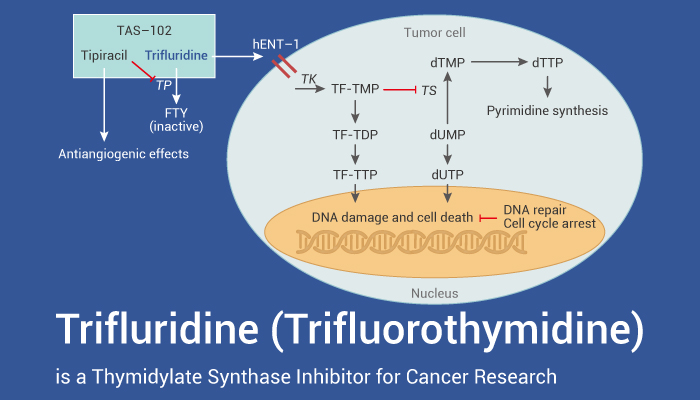Thymidylate synthetase (TS) is a key enzyme in DNA synthesis, which catalyzes the conversion of deoxyuridine monophosphate (dUMP) to deoxythymidine monophosphate (dTMP). TS inhibition leads to deoxynucleotide imbalance and increased dUMP levels, resulting in DNA damage. Triple-negative breast cancer (TNBC) is one of the most aggressive cancers, with a high rate of recurrence and metastasis. TS expression is up-regulated in breast cancer, especially in TNBC. Targeting TS is an effective strategy to treat TNBC. A potent thymidylate synthase inhibitor, Trifluridine (Trifluorothymidine) , is described here. It not only efficiently targets TNBC, but also has anti-herpes simplex virus activity.

Trifluridine is an irreversible, orally active thymidylate synthase inhibitor with antiviral and anticancer activities.
Trifluridine, a thymidine analogue, is reported to be able to insert into viral DNA to restrict viral DNA replication. It has broad-spectrum antiviral activity and can inhibit herpes virus (HSV), rhabdomyavirus and orthopoxvirus. Not only it (10 µM; 72 h) induces DNA double strand break (DSB) and damage in TNBC cells, but induces apoptosis. Trifluridine induces apoptosis via leading chromosomal instability and inhibiting thymidine synthase (5 µM-20 µM; 48 h); Or inhibition of autophagy in HUVEC via mTOR pathway (0.5 μM; 3 d). Trifluridine(0 µM-20 µM; 24-72 h) effectively inhibits HUVEC cell viability and inhibits the proliferation of breast cancer cell lines.
In vivo trials, Trifluridine/tipiracil (200 mg/kg; p.o.; twice daily for 5 consecutive days, in 6 weeks) shows antitumor activity in a human endoperitoneal xenograft model. Or it (75 or 150 mg/kg; p.o.) inhibits the growth of implanted TNBC tumors in mice.
In summary, Trifluridine is a potent thymidylate synthase inhibitor that can inhibit aggressive triple-negative breast cancer.
References:
[1]. Okayama T, et al. J Pharmacol Exp Ther. 2012 Feb;340(2):457-62.
[2]. Jia HJ, et al. Biochem Biophys Res Commun. 2022 Jun 25;610:119-126.
[3]. Suzuki N, et al. Oncol Lett. 2017 Jul;14(1):639-646.
[4]. Li J, et al. Am J Cancer Res. 2020 Feb 1;10(2):507-522.